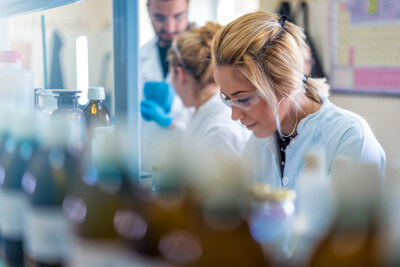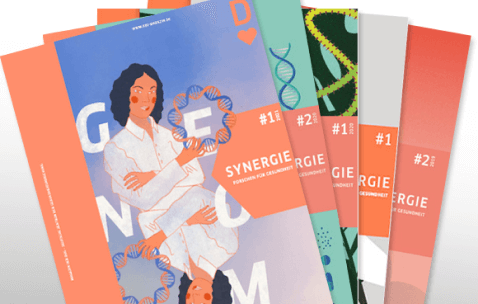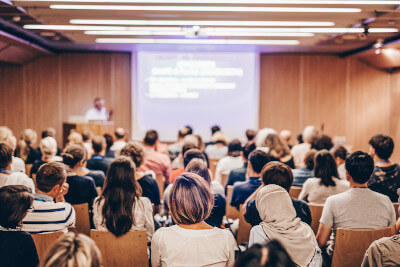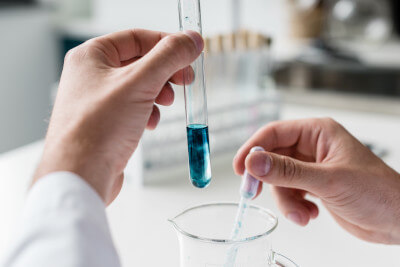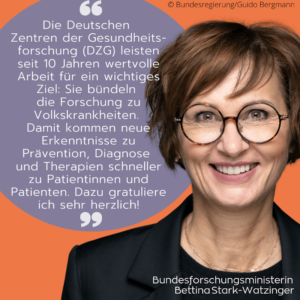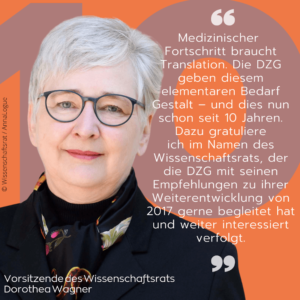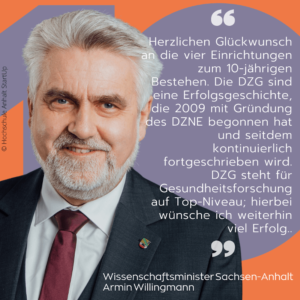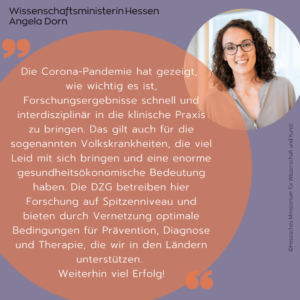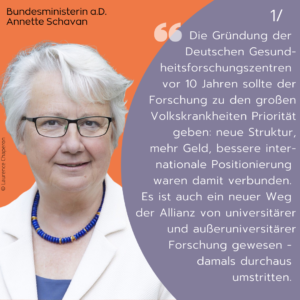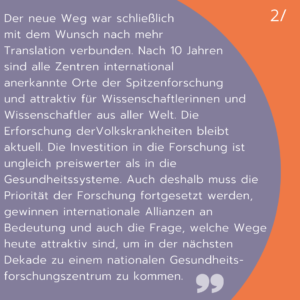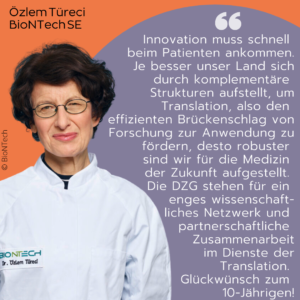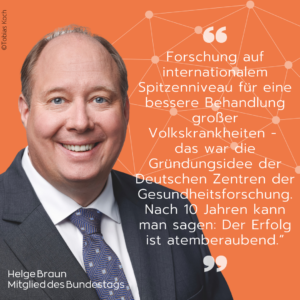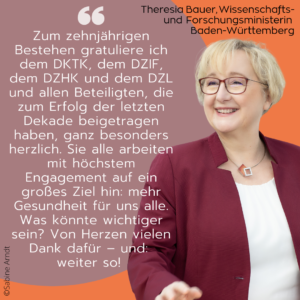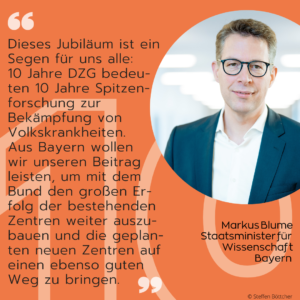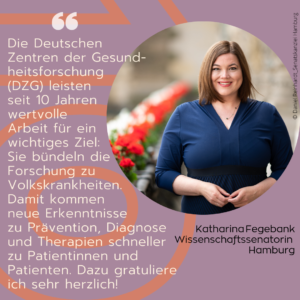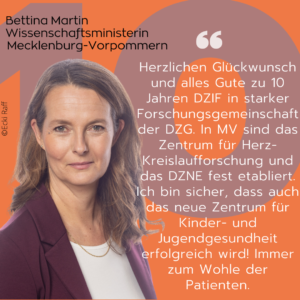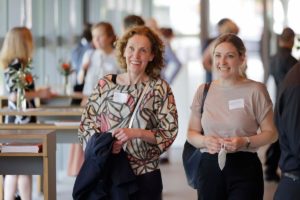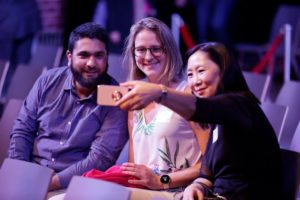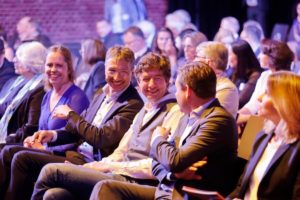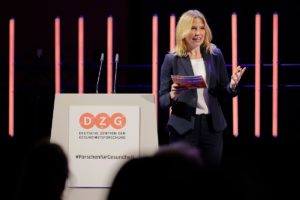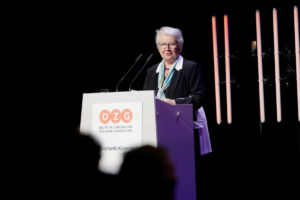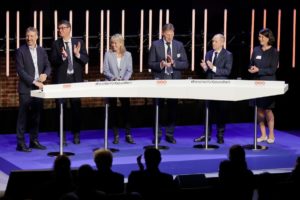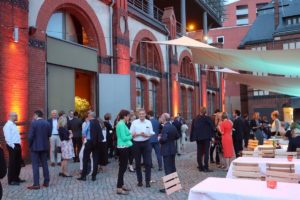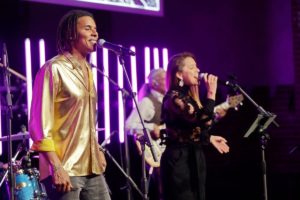10 Years of DZG
Four of six German Centers for Health Research are celebrating their 10th anniversary this year: the German Center for Lung Research, the German Center for Infection Research, the German Center for Cardiovascular Research and the German Cancer Consortium. The German Center for Diabetes Research (DZD) and the German Center for Neurodegenerative Diseases (DZNE) already celebrated their 10th anniversary in 2019.
For our birthday, numerous pioneers and companions from politics and science have sent us their congratulations, which we are happy to share here. Many congratulations will be added in the coming weeks.
You can also find the congratulations on our social media channels under the hashtags #ForschenfürGesundheit and #DZG.
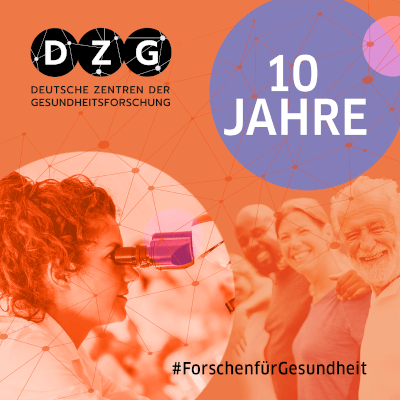
Anniversary celebration in Berlin
Four of six German Centres for Health Research (DZG) celebrated their tenth anniversary on May 19 with a ceremony in Berlin and around 300 guests from the worlds of politics and science. Federal Research Minister Bettina Stark-Watzinger, Hessian Science Minister Angela Dorn, Berlin State Secretary of Health Dr Thomas Götz, former Federal Research Minister Annette Schavan, Prof. Christian Drosten and BioNTech Co-Founder and Chief Medical Officer Prof. Özlem Türeci offered their congratulations at the event and digitally.
Pacesetters in health research
In a video message to the guests present, Minister Bettina Stark-Watzinger said, "The DZG have turned competitors into partners without losing sight of competition." She said they have succeeded in pooling the expertise of university and non-university research institutions, thus ensuring speed in health research.
In addition to the federal government as the DZG's largest donor, 13 German states are also important partners alongside the six centers. Hesse's Science Minister Angela Dorn, in whose state the DZG is represented by nine partner institutions, offered her congratulations in a video message, saying, "Only with the findings of science can the challenges of our time be mastered." The Corona pandemic, she said, showed how important it is to bring research results into clinical practice quickly and in an interdisciplinary way. "This also applies to the so-called widespread diseases, which bring a lot of suffering and have enormous health economic significance."
Reducing the administrative burden
The importance of a good funding basis and good networks was addressed by Berlin's State Secretary for Health, Dr. Thomas Götz, who welcomed the guests to the Radialsystem: These, he said, were crucial success factors not only for the former pumping station where the ceremony was held: "The strength of the DZGs is the networking of all activities in one indication area," the state secretary said. He also named the challenges for the centers and their funders at the federal and state levels: In addition to long-term financial and institutional planning security, he said, it would be desirable to reduce the administrative burden. "To this end, further ideas should be collected and intensively discussed as soon as possible. The states are ready for this with their responsible departments."
Closing the gap between junior research and senior research
DKTK junior scientist Dr. Theresa Suckert from Dresden reported on what networking can look like in practice. In a roundtable discussion with three other junior scientists from the centers, she said, "Clinician scientists, medical physicists, biologists and physicists worked closely together in my institute to answer a specific preclinical or clinical question." Munich-based DZL junior scientist and bioinformatician Meshal Ansari praised the opportunities for young researchers to present their work at conferences and workshops within the centers and to broaden their horizons through exchange. In her view, however, translation is unfortunately still too often thwarted by the slow pace of digitization in Germany.
Dr. Djawid Hashemi, a DZHK junior scientist and resident from Berlin, reported on the problem of "moonshine research", i.e. research that physicians often conduct in the clinic after hours. He said that DZHK funding helps him to better manage the balancing act between clinic and research with protected time for scientific projects. He criticized the still rather conservative field of medicine with strong hierarchies: "With the promotion of women and young scientists, the DZHK, for example, acts here like an engine to accelerate change," said the young cardiologist.
Physician and DZIF researcher Dr. Julia Pagel from Hamburg gave an example of how it is possible to reconcile research and family with the help of special scholarships: "A DZIF Maternity Leave Scholarship enabled me to seamlessly continue my scientific project after parental leave." In addition, she says, DZIF funding helped her, as a clinician, to receive additional scientific training in the host laboratory. The scientist sees a challenge in better closing the gap between junior funding and the senior field. "Too often, exciting research projects from residency still get bogged down in the demanding clinical routine," she says.
Communication between science and politics should be a permanent process
The translation gap is the real challenge in many fields of the life sciences, said Prof. Dr. Christian Drosten in an interview. The virologist from Charité Berlin is a scientist at the German Center for Infection Research. Closing this gap costs a lot of money and needs staying power, he said: thorough basic research alone as a basis for broad and applied research takes time. He wished for continuity from politics and emphasized that communication between science and politics must become a permanent process and be seen as a long-term gain.
More insights into regulatory and production processes in science education
"How to translate science into survival?" was the title of the keynote address by Prof. Dr. Özlem Türeci, who joined live. The Chief Medical Officer of BioNTech and DKFZ scientist described how her company had succeeded in harnessing research into individual cancer vaccines for a coronavirus vaccine and human application in record time: Over decades of work, she said, they had developed the mRNA technology to the point where it remained stable in a cell. With lipid envelopes, they would have found the appropriate "packaging system" for the mRNA, and their team would have been able to develop customized mRNA vaccines for cancer patients within a few weeks. With her example, Prof. Türeci made it clear that "science and technology can make a difference, no matter how small the question may be or whether it seems purely basic science." Translational research, moreover, always means looking beyond one's own nose, she said: She would like to see more insight into regulatory and production processes for physicians and scientists in training. It is also important that accompanying research or the innovation of a production technology receive the same recognition as basic scientific findings.
European alliances for the best promotion of talent
The fact that international action is more important than ever, not only for companies like BioNTech, but also for Germany as a research location as a whole, was pointed out by the former Minister for Education Research, Dr. h.c. Annette Schavan. The initiation of the DZG took place during her term of office. Even then, Schavan said, the question was how Germany and Europe could offer the best conditions to attract the best researchers from all over the world. She wanted to see more ambition on this issue: "The great mission lies in European alliances for the best promotion of talent through strategic programs," said the former federal minister.
Improve readiness for spin-offs and get industry partners on board earlier
In a subsequent panel discussion, the spokespersons of the four anniversary DZGs spoke with moderator Dr. Julia Fischer about translational research successes that the individual centers have achieved over the past ten years. But they also pointed out where improvements are needed now and for the future: In order to attract the top people from around the world, one thing is fundamental for the centers, said Prof. Werner Seeger of the DZL: "We need to move away from short-term budget commitments to longer-term funding perspectives." The speakers saw a need for action, in particular, to share and sustainably use research data, facilitate spin-off readiness and meet with industry partners earlier than before. In addition to interaction with industry, interaction with regulators is also an important adjusting screw to accelerate translational research processes, according to Prof. Michael Baumann of the DKTK. DZHK spokesperson Prof. Stefanie Dimmeler also saw room for improvement here: "I would like to see mandatory accompanying training concepts that enable younger colleagues to learn about patenting aspects and interaction with regulatory authorities," she said. Prof. Dirk Busch from the DZIF presented an example of successful cooperation between the centers, which starts with regulatory issues, among other things: The Product Development Unit of the DZIF helps to initiate industry partnerships and with spin-off issues and also supervises two DZHK projects.
You are currently viewing a placeholder content from Default. To access the actual content, click the button below. Please note that doing so will share data with third-party providers.
More InformationYou are currently viewing a placeholder content from Default. To access the actual content, click the button below. Please note that doing so will share data with third-party providers.
More InformationPhoto gallery
We have compiled a small review of the celebration. This link will take you to the full picture gallery: 10 Years of DZG in pictures
